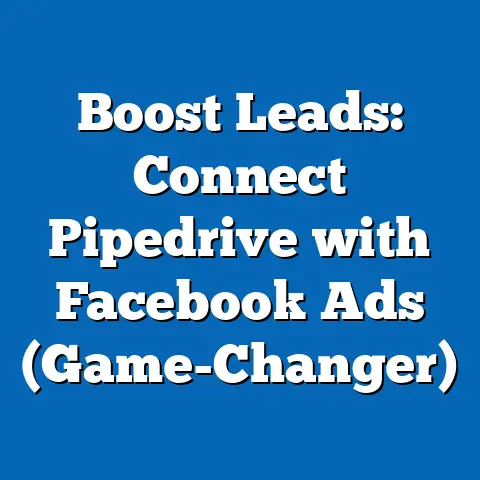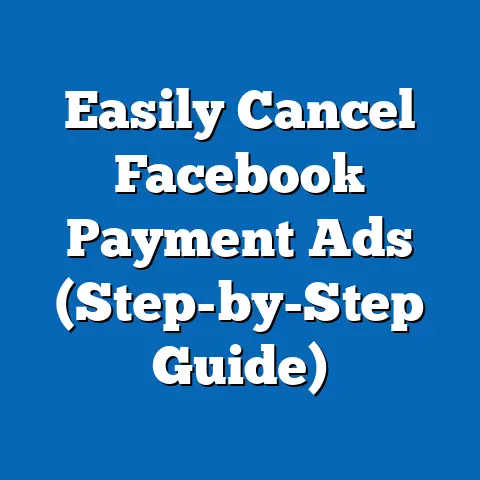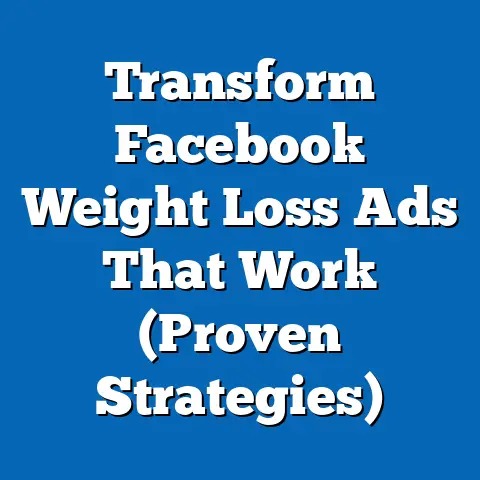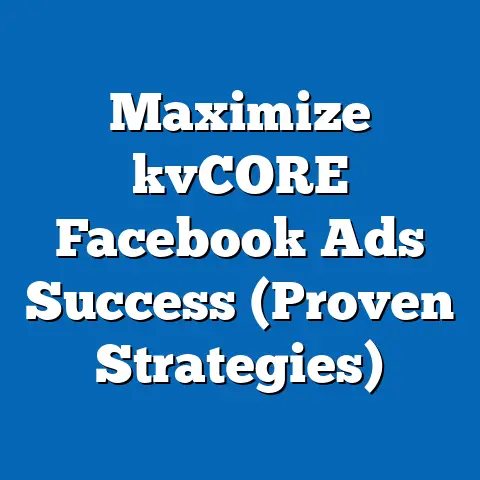Unlock Facebook Ad Preferences (Essential Guide)
Have you ever felt like Facebook knows you a little too well? Like it’s reading your mind and serving up ads for that exact thing you were just thinking about? I remember a time when I was casually browsing for hiking boots online, and suddenly, my Facebook feed was flooded with ads for every brand imaginable. It was both fascinating and slightly unsettling. That’s the power of Facebook’s advertising platform, and it all boils down to understanding and leveraging ad preferences.
But it’s not just about feeling targeted; it’s about control. As a user, you have the power to shape your ad experience, making it more relevant and less intrusive. And as an advertiser, understanding these preferences is the key to unlocking higher conversion rates and a more engaged audience. This guide will walk you through everything you need to know about Facebook ad preferences, whether you’re a user wanting to take control or an advertiser looking to boost your campaign performance.
Section 1: Understanding Facebook Ad Preferences
At its core, Facebook ad preferences are the settings that determine which ads you see on the platform. They’re a complex web of data points that Facebook uses to understand your interests, behaviors, and demographics, allowing advertisers to target their campaigns with incredible precision.
What are Facebook Ad Preferences?
Think of Facebook ad preferences as your digital fingerprint. They encompass a wide range of information, including:
- Demographics: Age, gender, location, education, relationship status.
- Interests: Hobbies, passions, topics you engage with (e.g., cooking, travel, technology).
- Behaviors: Online activities, purchases, app usage, website visits.
- Connections: Pages you like, groups you’re a member of, friends you interact with.
- Custom Audiences: Information advertisers upload based on their own customer data (e.g., email lists).
How Facebook Collects Data
Facebook is a data-collecting machine. Every like, share, comment, and click contributes to your ad profile. Here’s a glimpse into their data-gathering methods:
- Directly Provided Information: This is the information you willingly share when creating your profile or filling out forms on Facebook.
- Observed Behavior: Facebook tracks your activity on the platform, including the pages you visit, the posts you interact with, and the ads you click on.
- Data from Third-Party Websites and Apps: Facebook uses the Facebook Pixel, a snippet of code that allows them to track your activity on websites and apps that have integrated with Facebook. This is how they know you were browsing for hiking boots, even if you weren’t on Facebook at the time.
- Offline Activity: Facebook can also collect data from offline sources, such as loyalty programs and purchase history, through partnerships with businesses.
The Role of User Engagement
Your engagement with content on Facebook is a major indicator of your interests. If you consistently like posts about vegan recipes, Facebook will likely categorize you as someone interested in veganism and show you ads related to plant-based products and services. The more you interact, the more refined your ad profile becomes.
Key Takeaway: Facebook ad preferences are a dynamic reflection of your online and offline activities, constantly evolving as you interact with the platform.
Section 2: Navigating Facebook Ad Preferences
Taking control of your ad experience starts with understanding how to access and modify your ad preferences. Here’s a step-by-step guide:
Accessing Your Ad Preferences
- Log into Facebook: Start by logging into your Facebook account on a computer or mobile device.
- Navigate to Settings: Click on the downward-facing arrow in the top right corner of the screen and select “Settings & Privacy,” then click “Settings.”
- Go to Ads: In the left-hand menu, click on “Ads.” This will take you to the main Ad Preferences page.
Exploring the Ad Preferences Sections
The Ad Preferences page is divided into several sections, each offering different levels of control over your ad experience:
- Advertisers: This section shows you a list of advertisers whose ads you’ve interacted with on Facebook. You can click on each advertiser to see more details about their targeting criteria and choose to hide ads from specific advertisers.
- Ad Topics: This section allows you to see topics that Facebook thinks you are interested in and allows you to remove them.
- Ad Settings: This is where you can control how Facebook uses your data to show you ads. You can manage settings related to:
- Data about your activity from partners: This controls whether Facebook can use data from websites and apps you visit to show you ads.
- Ads shown outside of Meta: This controls whether Facebook can use your data to show you ads on other websites and apps.
- Social actions: This controls whether your likes and comments can be shown in ads to your friends.
- Data about your activity from partners: This controls whether Facebook can use data from websites and apps you visit to show you ads.
- Ads shown outside of Meta: This controls whether Facebook can use your data to show you ads on other websites and apps.
- Social actions: This controls whether your likes and comments can be shown in ads to your friends.
Modifying Your Ad Preferences
Now that you’ve explored the different sections, it’s time to start customizing your ad preferences:
- Hide Ads from Specific Advertisers: If you’re consistently seeing ads from a particular advertiser that you find annoying or irrelevant, you can choose to hide their ads.
- Update Your Interests: Review the list of interests that Facebook has assigned to you and remove any that are inaccurate or no longer relevant. You can also add new interests to help Facebook show you more relevant ads.
- Adjust Your Data Settings: Carefully review the data settings in the “Ad Settings” section and adjust them according to your preferences. Consider limiting the use of data from partners and social actions to protect your privacy.
Pro Tip: Regularly revisiting your ad preferences is crucial. Your interests and behaviors change over time, so it’s important to keep your ad profile up-to-date to ensure you’re seeing relevant ads.
Key Takeaway: Navigating and modifying your Facebook ad preferences is a simple but powerful way to take control of your ad experience and protect your privacy.
Section 3: The Importance of Customizing Ad Preferences
Customizing your ad preferences isn’t just about seeing fewer annoying ads; it’s about creating a more personalized and enjoyable experience on Facebook.
Benefits for Users
- Enhanced User Experience: By tailoring your ad preferences, you can reduce the number of irrelevant ads you see, making your Facebook feed less cluttered and more engaging.
- Discovery of Relevant Products and Services: Customizing your interests can help you discover products and services that genuinely interest you. Imagine finding a new favorite book or a local restaurant you never knew existed, all through a well-targeted ad.
- Increased Privacy: By limiting the use of your data, you can protect your privacy and reduce the amount of information that Facebook shares with advertisers.
Risks of Not Managing Ad Preferences
- Overwhelming Ad Clutter: Without customizing your ad preferences, you’re likely to be bombarded with ads that are irrelevant to your interests, making your Facebook experience overwhelming and frustrating.
- Exposure to Irrelevant or Offensive Ads: You may be exposed to ads that are offensive or simply don’t align with your values. For example, if you’re not interested in gambling, you might see ads for online casinos, which can be annoying and even triggering for some users.
- Potential Privacy Concerns: By not managing your data settings, you’re giving Facebook more freedom to share your information with advertisers, which could raise privacy concerns.
Personal Story: I once helped my grandmother customize her Facebook ad preferences. She was constantly complaining about seeing ads for products she had no interest in, like sports cars and video games. After spending just 30 minutes updating her interests and adjusting her data settings, she noticed a significant improvement in the quality of the ads she was seeing. She even discovered a few local gardening groups that she ended up joining!
Key Takeaway: Customizing your ad preferences is a proactive step towards creating a more personalized, enjoyable, and private Facebook experience.
Section 4: The Impact of Ad Preferences on Advertisers
Understanding ad preferences isn’t just beneficial for users; it’s also crucial for advertisers looking to maximize their campaign performance.
Targeting Options Based on User Preferences
Facebook offers a wide range of targeting options based on user preferences, allowing advertisers to reach specific audiences with incredible precision. These options include:
- Interest-Based Targeting: Target users based on their expressed interests, hobbies, and passions.
- Behavioral Targeting: Target users based on their online activities, purchase history, and app usage.
- Demographic Targeting: Target users based on their age, gender, location, education, and relationship status.
- Custom Audiences: Upload your own customer data (e.g., email lists) to target existing customers or create lookalike audiences.
- Lookalike Audiences: Target users who share similar characteristics and behaviors with your existing customers.
Higher Conversion Rates Through Customized Ads
By leveraging user preferences, advertisers can create ads that are highly relevant to their target audience, leading to higher engagement rates, click-through rates, and ultimately, conversion rates. When an ad resonates with a user’s interests and needs, they’re more likely to click on it, visit your website, and make a purchase.
Examples of Successful Ad Campaigns
- Airbnb: Airbnb uses interest-based targeting to show ads to users who are interested in travel, adventure, and unique experiences. They also use lookalike audiences to reach new users who are similar to their existing customers.
- Nike: Nike uses behavioral targeting to show ads to users who are interested in fitness, sports, and athletic apparel. They also use custom audiences to target existing customers with personalized offers and promotions.
- Sephora: Sephora uses demographic targeting to show ads to women who are interested in beauty products and cosmetics. They also use interest-based targeting to reach users who are interested in specific brands and products.
Expert Insight: According to a study by HubSpot, personalized ads have a 6x higher conversion rate than generic ads. This highlights the importance of understanding and leveraging user preferences to create effective ad campaigns.
Key Takeaway: Understanding and leveraging user preferences is essential for advertisers looking to create highly targeted, relevant, and effective ad campaigns.
Section 5: Strategies for Users and Advertisers
Now that you understand the importance of ad preferences, let’s explore some actionable strategies for both users and advertisers.
Strategies for Users
- Regularly Review and Update Your Preferences: Make it a habit to review your ad preferences every few months to ensure they’re still accurate and relevant.
- Engage with Ads That Resonate: When you see an ad that you find interesting or helpful, engage with it by liking, commenting, or sharing it. This will help Facebook understand your interests and show you more relevant ads in the future.
- Hide Ads That Are Irrelevant or Offensive: If you see an ad that you find irrelevant or offensive, hide it and provide feedback to Facebook. This will help them improve the quality of their ads and show you fewer ads that you don’t like.
- Adjust Your Data Settings: Take control of your data by adjusting the settings in the “Ad Settings” section. Consider limiting the use of data from partners and social actions to protect your privacy.
Strategies for Advertisers
- Conduct Thorough Audience Research: Before launching an ad campaign, take the time to research your target audience and understand their interests, behaviors, and demographics.
- Use A/B Testing to Optimize Your Ads: Experiment with different ad creatives, targeting options, and bidding strategies to see what works best for your target audience.
- Segment Your Audience: Divide your audience into smaller, more specific segments based on their preferences and behaviors. This will allow you to create ads that are highly relevant to each segment.
- Monitor Ad Performance and User Engagement: Use Facebook’s analytics tools to track the performance of your ads and monitor user engagement. This will help you identify areas for improvement and optimize your campaigns for better results.
- Create High-Quality, Engaging Content: Focus on creating ads that are informative, entertaining, and relevant to your target audience. Avoid using clickbait or misleading tactics, as this can damage your brand reputation.
Personal Experience: I’ve seen firsthand how effective A/B testing can be for optimizing ad campaigns. In one instance, I was managing a campaign for an e-commerce store selling handmade jewelry. We tested two different ad creatives: one featuring a close-up shot of the jewelry and the other featuring a lifestyle shot of someone wearing the jewelry. The lifestyle shot outperformed the close-up shot by a significant margin, resulting in a 30% increase in sales.
Key Takeaway: By implementing these strategies, both users and advertisers can create a more personalized, relevant, and effective Facebook experience.
Section 6: Future Trends in Facebook Advertising
The world of Facebook advertising is constantly evolving, with new trends and technologies emerging all the time. Here’s a glimpse into the future of Facebook advertising and user preferences:
Growing Importance of Privacy and Data Security
As users become more aware of privacy issues, they’re demanding greater control over their data. Facebook is responding to these demands by implementing new privacy features and regulations, such as the General Data Protection Regulation (GDPR) and the California Consumer Privacy Act (CCPA).
The Rise of Personalized Advertising
Personalized advertising is becoming increasingly sophisticated, with advertisers using advanced technologies like artificial intelligence (AI) and machine learning (ML) to create ads that are tailored to individual user preferences.
The Metaverse and Virtual Advertising
With the rise of the metaverse, Facebook is exploring new opportunities for virtual advertising. Imagine seeing ads for virtual clothing or accessories while exploring a virtual world.
The Importance of Authenticity and Transparency
As users become more savvy about advertising, they’re demanding greater authenticity and transparency from brands. This means being honest about your products and services and avoiding misleading or deceptive tactics.
Expert Prediction: According to a report by eMarketer, spending on personalized advertising will continue to grow in the coming years, reaching \$335 billion by 2025. This highlights the importance of staying ahead of the curve and adapting to the changing landscape of Facebook advertising.
Key Takeaway: The future of Facebook advertising will be shaped by privacy concerns, personalized advertising, the metaverse, and the demand for authenticity and transparency.
Conclusion
Understanding Facebook ad preferences is essential for both users and advertisers. For users, it’s about taking control of your ad experience, protecting your privacy, and discovering products and services that genuinely interest you. For advertisers, it’s about creating highly targeted, relevant, and effective ad campaigns that drive results.
By implementing the strategies outlined in this guide, you can unlock the power of Facebook ad preferences and create a more personalized, engaging, and profitable experience on the platform. So, take control of your ad preferences today and explore the world of Facebook advertising for your benefit!
Are you ready to take control of your Facebook ad experience? Start by navigating to your Ad Preferences page and adjusting your settings. And if you’re an advertiser, start conducting thorough audience research and experimenting with different targeting options to create ads that resonate with your target audience. The possibilities are endless!





